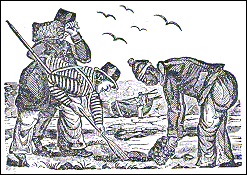Game Overview
 We all draw up treasure maps and bury things as children. Most of these items are simple but very precious to us — marbles, coins, secret notes or baseball cards. Sometimes we put them in glass jars to dig them up on another day. Of course this is part of the playful times of childhood. But we all hope deep down in our hearts that when we finally unearth them we instead discover a magical treasure filled with gold, diamonds or fabulous riches. The Buried Treasure Game is our quest to fulfill that childhood dream. But in this case, the search is as fulfilling and rewarding as the prize itself.
We all draw up treasure maps and bury things as children. Most of these items are simple but very precious to us — marbles, coins, secret notes or baseball cards. Sometimes we put them in glass jars to dig them up on another day. Of course this is part of the playful times of childhood. But we all hope deep down in our hearts that when we finally unearth them we instead discover a magical treasure filled with gold, diamonds or fabulous riches. The Buried Treasure Game is our quest to fulfill that childhood dream. But in this case, the search is as fulfilling and rewarding as the prize itself.
After finding the treasure, it has taken a full year to create The Buried Treasure Game. Ross Martin believes that this is a book that the whole family will be able to take an active role in participation. His vision was to write a book that supported the search of finding the buried treasure, and the ability to offer a more participatory experience. Books are some of life’s real treasures and local libraries are the keys to unlocking some of the best information in the world. We all know that “family values” and “quality time” have become trite sayings in our everyday language, but this is a book and game that can really bring these ideas together. Reading can be such a wonderfully interactive experience so, with his quest for wholesome family quality time, The Buried Treasure Game can stimulate both family reading and research in an active learning environment.
Here are three of the 100 questions presented in the game.
10. And I think about those people, who mean so much to me, and for so many years have made me, so very happy, and I count the times I have forgotten to say thank you, and just how much I love them…
Name the song.
16. Power lines, swamp, practical jokes, radio control airplane, 2 homes, fire, expelled from school.
Name the movie.
25. Nor was it a passive waiting. Cosmopolitan Magazine, 1970’s.
Name the page number.
Answering these and the other 97 questions will test your ability to locate and understand reference information – most of which is available at public libraries. You and your family or friends can use any source you desire to answer the questions. You may wish to call your local radio station to see if any of the station’s listeners can help with a song title. You might want to sign on to the Internet to see if anyone can help you with a movie question. Or, maybe you could contact your local newspaper for the answer to a trivia question. In the end, you will probably use many different sources in your quest to find the correct information.
There are many benefits in playing the game. It is an exciting opportunity for children and adults ages 13 and older and is perfect for a family, school, work, group or community project. Multiple people can play the same game and reap the rewards of play. And, it’s a great project to stimulate research and adventure in a group setting.
The game is also simple, relaxing, and easy to play. There is no proficiency in skill or knowledge required. It is not a game of luck like playing the lottery where your chance of winning is millions to one. This will also limit our total payout of prize money that is available. Unlike all other treasure hunts, clues are not elusive and overall game play is very easy for the average reader. Rules are limited to just a few pages. The entire game can be played from the convenience of your home.
All participants have the same questions and clues along with the same opportunity to win the $50,000 prize. This means that unlike any other game, each participant competes against themself and time. Everyone that plays can win. Participants do not have to travel to the location to win the prize – simply identify the treasure location. The Book will also clearly overview how multiple people can win the $50,000 easily. 
As an option, at any time during the year, you can receive a statistical analysis of participants playing the game. Every time you correctly answer each set of 25 questions, you will be asked to send us this information. For example, we can provide information regarding total participants that have reached certain levels of correct answers, as well as stats of participants by age, sex, geographic location, and other interesting game data.

